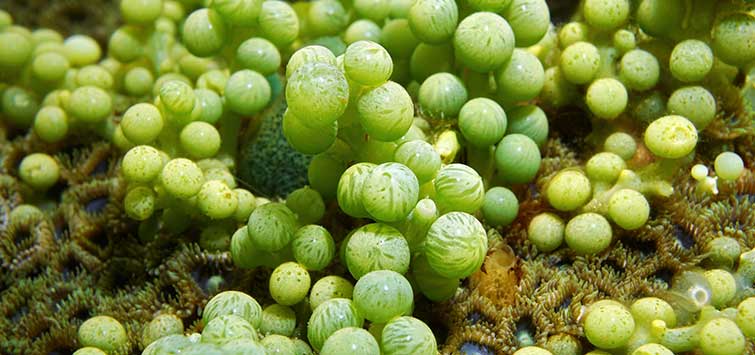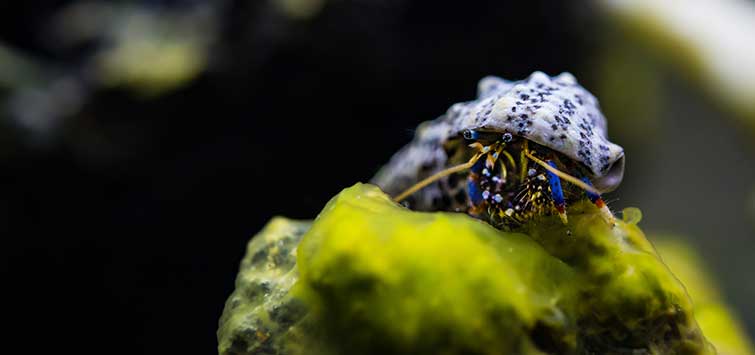Exploring Marine Algae on Coral Reefs and Beyond
Marine algae plays a vital role in just about every saltwater ecosystem you can think of, with the possible exception of deep-sea hydrothermal vents. Without algae, tropical reefs as we know them could not exist. Being primary producers (as biologists term them), algae are at the bottom of the food chain, providing the “power” for marine ecosystems. Whether it is by providing sugars in the tissues of reef-building corals or rich grazing for herbivorous fish, reefs rely on algae.
And it’s not just in the tropics where algae species are fundamental. Around the world, from the cold seas close to my home in Scotland to more temperate waters off the Atlantic coast of the United States, marine algae flourish. Of these, the most notable are the huge growths of macroalgae, the keystone species that create some of the richest and most productive habitats on the planet, specifically the huge stands of what we loosely call “kelp,” which show exceptional growth rates and support large numbers of animal species, from fish to sea otters, in what are known as kelp forests.
A Variety of Algae Types
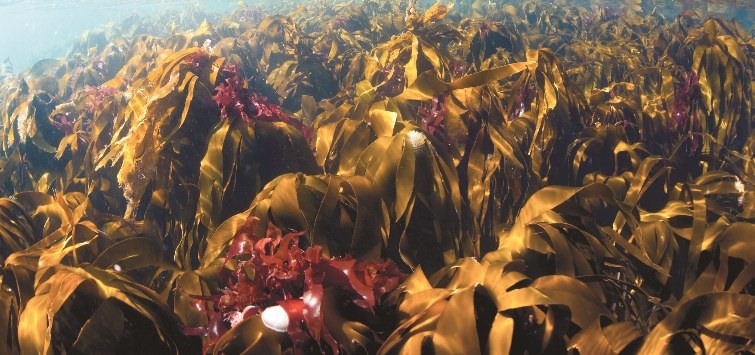
Not all algae resembles the leafy growths we see in the kelps and wracks that are common “seaweeds” in the class Phaeophyceae, the brown algae. Many algal genera are rigid and hard to the touch, indicating they form skeletons of calcium which can encrust rock and, in many cases, other marine organisms. Where conditions are favorable and in conjunction with other calcium-depositing marine organisms such as serpulid worms, algal growths can create reefs in their own right.
Some calcareous algae are common on rocky shorelines, while others are found in less well-lit, often deeper habitats. Marine aquarists rightfully take pride in their growths of coralline algae, and in highly illuminated tanks, its colorful growth may be found even in the shadows.
In this article I want to share with you some of the interesting environments I’ve explored around the world and to see if they might offer some inspiration for the development and the care of algae in aquaria. Firstly though, what exactly is algae? Well, for aquarists there are two types: the types you want and the types you do not.
Scientifically it’s a lot more complicated, but for this article I’m going to ignore the rarer types and only refer to familiar species from the three most common phyla that we all come across from time to time: the red algae (Rhodophyta), the green algae (Chlorophyta) and the brown algae (Phaeophyta).
Red algae are some of the most useful in the aquarium. Anyone who has fed Nori to their tangs, or enjoyed sushi rolls, will be fans of the genus Porphyra. This phylum also contains the coralline algae, which we’ll look at later.
Brown algae are the typical seaweeds of temperate shorelines and are sometimes grown in specialist tanks, though with many species being seasonal, they tend to fall apart after a while. Having said that, some aquarists may come across algae of the order Sargassaceae, sometimes on newly imported live rock, though it’s not something I’ve seen growing in captivity with any success.
The green algae are a fiendishly complicated group to wrap your head around, with many classes of microscopic species further confusing all but the experts. Many of these types will grace your rockwork and tank walls from time to time. There are also a few more familiar classes such as the Ulvophyceae, which holds the orders that contain the well-known macroalgae, such as Caulerpa, Chaetomorpha, and Halimeda.
Why Grow Marine Algae?
There are two reasons an aquarist would want to cultivate a growth of algae: for its functionality, and for the challenge of replicating an interesting biotope.
Its functional uses include the cultivation of macroalgae in a well-lit refugium, where algae are grown for nutrient export in reef setups. A batch of good ol’ Chaetomorpha grown in the sump can provide a very useful means of removing nutrients from your system, as well as offering a home for useful animals such as copepods—which your fishes find to be a tasty and nutritious snack when they find their way into your tank.
Growing algae for aesthetic reasons is often a little harder, but worth the challenge, especially when trying to replicate a specific biotope. To that end I’m going to look at one of the best algae to try, Halimeda.
Halimeda
Of all the green algae I’ve come across on my travels, I’ve found Halimeda to be the most widespread. There are more than 30 species of Halimeda around the world—I’ve seen it in the Indian Ocean, the Mediterranean, and across the tropical Western Atlantic, and I’ve always marveled at how intense its green coloration is. This is especially striking because green is a color often lacking on reefs replete with browns, pinks, and mauves.
What sets Halimeda apart is its ability (which some other species in the order Bryopsidales share) to extract calcium carbonate from the water to build a semi-rigid internal framework, over which tissue forms.
Halimeda produces long growths of segments, each with a core of calcium carbonate surrounded by living tissue. Similar to related genera such as Caulerpa, each “leaf” is one single cell. Halimeda is not difficult to grow, but it is fragile and will not take well to pruning or disturbance in my experience.
Halimeda is considered to be easy to keep in an aquarium, and when growing with and among sessile invertebrates, it makes quite a sight, though I suspect it could become a nuisance if growing alongside corals and shading them out.
Being a calcium-depositing species, Halimeda will deplete calcium levels, of course. In the wild the growth and ultimate death of Halimeda is responsible for creating a lot of the fine sandy substrate on the sea floor, and along with the work of parrotfish, contributes to those beaches we enjoy walking on so much.
Caulerpa
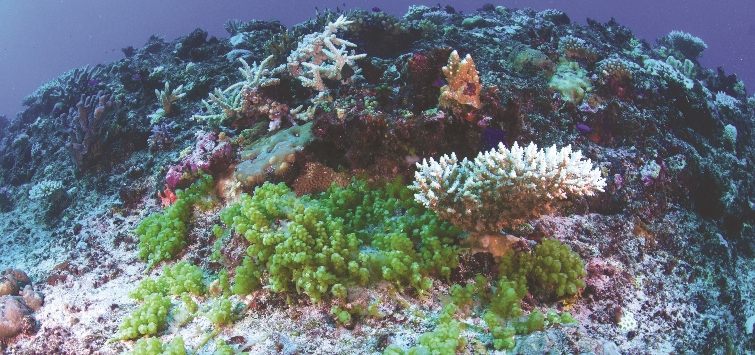
When I first set up a marine aquarium, I wanted to combine it with my other interest of gardening. Naturally, I acquired some Caulerpa and it prospered…for a few weeks, that is, and then it crashed. I suspect many aquarists will have come across this issue.
It is said the key is to regularly prune it to prevent it from developing to the point where it begins to reproduce. In my experience, it does not always recover, and in a low-nutrient tank, especially with a grazer or two, it disappears completely. Some folks do have success with it in refugia, where the various forms of Caulerpa can look spectacular.
Caulerpa comes in a variety of shapes and sizes, with a common feature of a “runner,” or stolon, to use the correct term, which runs across the substrate and gives rise to fronds that may be blade-shaped as in Caulerpa prolifera, or featherlike as in C. taxifolia. Personally, I prefer some of the species such as C. racemosa—also known as sea grapes—which have a very alien look to them.
Do be careful, though. In the wild, when Caulerpa is stressed, it has evolved to form massive numbers of spores in its flesh before apparently dying off. In the wild the spores find a more favorable location, but in your tank… well, you’ll have a lot of nutrients to deal with, to say the least.
Fish Camouflage
It’s worth taking a moment here to look at some of the fish from algal habitats. Many species that live their entire lives or, as is commonly the case, just their juvenile phase in the generally shallower algae-rich waters have developed amazing camouflage. My favorite of these and one that I always take great pleasure in finding in the wild are the leaf scorpionfishes.
Leaf scorpionfishes are slow-moving ambush predators that rely heavily on their camouflage to stay unseen by predators and prey alike. Not only do they rely on coloring and pattern, but their fins and skin have evolved to resemble algal growths. As you can see, they closely resemble their relatives the lionfishes.
Excellent camouflage in algae-rich environments is not limited just to those groups, either. I’ve come across a diverse variety of species that are experts at staying hidden among the algae—to the extent where you can spend an entire dive trying to find an animal that has been sitting a few inches away from you the entire time.
This trait is perhaps best exemplified by the seahorses, many of which are masters of camouflage. I know many divers with thousands of dives logged who have only seen one or two of these highly cryptic animals. In a display aquarium, stocking species like leaf fish or seahorses that are hard to see may be somewhat counterintuitive, but they certainly are interesting.
Coralline Algae
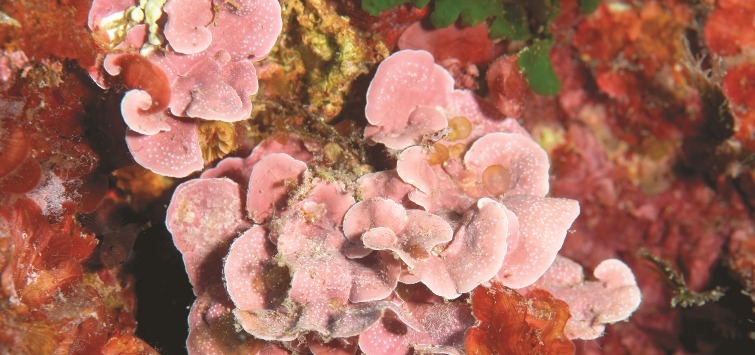
As I’m sure you’ve come to expect by now, the taxonomy of red algae is complex, and if I’m being honest, a bit of a boring topic for most folks, so I find it best to classify coralline algae as being in two categories: the encrusting kind, and the kind that grows away from the rock in plates, branches, or whorls.
Growing coralline algae in captivity is not too difficult. In many instances it will simply arrive with live rock and spread under its own steam. You can speed this up by pulverizing algae-rich live rock and adding the resulting mess into the tank with filtration systems switched off. I’ve heard people say an old coffee grinder is ideal for this purpose.
In time and with good water chemistry management, coralline algae will develop well in most systems and may well outcompete some of the more nuisance types of algae, especially in tanks where nutrient control is difficult. The types of coralline algae you grow will depend on your lighting to a great extent, with many varieties tolerating lower light levels than many typical reef aquariums employ.
A Worthy Challenge
I hope this short introduction into this very complex subject has been of value. Algae, as a subject of study, can be a challenge. To illustrate my point: I have a guidebook to the native species around the UK. It’s thick and often suggests you look at characteristics with a magnifying glass or microscope in order to properly identify species.
But don’t let the diversity of algae put you off understanding them; a few simple categories like I have used in this piece are perhaps all that is needed amongst non-experts, in order to get to grips with the various algae’s needs and requirements.
Keeping marine algae can be a challenge, and at any given time you may be trying to eradicate some species while trying to encourage others to grow. You may find some species will never prosper for you, while other aquarists are giving the stuff away by the bucketful. Figuring out why is perhaps the real challenge—and no small amount of fun!

.png?h=595&iar=0&w=2781&hash=5FD5E69473BCC22199FBFA2FB71B6033)


